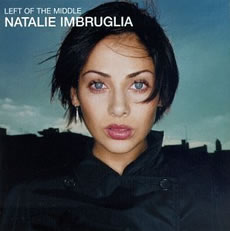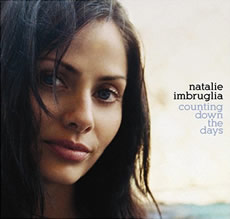
Image © RCA Records 1998

Image © RCA Records 2002

Image © Brightside Recordings 2005
|
|
(16 August 2005) Natalie Imbruglia is certainly not your average soap starlet-turned-pop singer. Although, like Kylie Minogue in the 80s, and Holly Valance in the late 90s--not to mention a whole host of lesser names--she quit the Australian soap Neighbours to pursue a music career, she has taken a markedly different path. Whereas Minogue chose bugglegum pop under 80s moguls Stock-Aitken-Waterman, and Valance upped the sex content with a risqué, yet hollow dance music career, Natalie deliberately toned down her stunning, Italian / Australian looks, cut her hair and took far too time with her first album to be accused of "cashing in" on her fame. Left of the Middle. The result, finally released in the UK in 1997, was the superb debut album Left of the Middle RCA (USA) 0786367634-2, 1998). In her promotional work on the album, Natalie was quick to distance herself from other soap actresses come pop stars, emphasising her indie-influenced song-writing abilities and the credibility of her producer, former Cure bassist Phil Thornally. This backfired slightly, when it was revealed that "Torn," the first, huge, UK hit single from the album, was written for her rather than by her. Indeed, Natalie has always worn her credibility on her sleeve, rather. Despite her obvious song-writing talents, and decent voice, she has combined a life in music with a stop-start acting career and a recent stint as the "Face" of L'Oreal. Playing Left of the Middle again for the first time in a while, it is amazing how fresh it sounds. Its twelve tracks are varied, yet there is a consistent overall tone to the album which works beautifully under the guiding hand of Thornally, who wrings every last drop of emotion out of Natalie's somewhat limited voice. The overall indie feel is tempered by an appealing funkiness throughout, and the mid 90s production effects have not dated too badly. Wisely getting "Torn" out of the way early, the excellent "One More Addiction" is up next, followed by album highlight "Big Mistake," with its brooding verse and violent chorus. "Leave me alone" betrays a Bjork influence, as does the surreal "Smoke." Sandwiched between them is "Wishing I Was There," which, with its strong acoustic guitar, is a precursor of later albums. The breathy "Pigeons and Crumbs" is followed by the superb, crunching funky rock--suggesting compatriots INXS--of "Don't You Think." "Impressed" sounds a little like 90s Kylie Minogue, but works well in the context of the album, and is followed by the glorious, Alanis Morrisette-influenced "Intuition." To close the album, the rocker swagger of "City"  is followed by the gentle, acoustic title track. Overall, this was a superb, cohesive debut without a bad track on it. It deservedly sold six million copies worldwide. is followed by the gentle, acoustic title track. Overall, this was a superb, cohesive debut without a bad track on it. It deservedly sold six million copies worldwide.  White Lilies Island. Four years later, just as we thought that Natalie had gone forever, she produced another twelve-song collection, White Lilies Island (RCA (UK), 7432 191342 2, 2002). Gone was the edgy indie image, replaced by something a lot softer. Furthermore, there was an obvious desire to emphasise song writing over style--a creditable attitude, but one that requires the very best material. Natalie chose well; te hugely talented Scottish musician Gary Clark shared writing credits with Natalie on nine of the album's songs, producing and playing on almost every track. However, their collaboration was only partially successful, and the album is somewhat patchy. The distinctive "That Day" (actually produced by Ian Stanley) opens the album and was the first single, while "Beauty on Fire" continues the good early standard. The sweet "Satellite." Its relatively simple arrangement--typical of the album--is up next, followed by the splendid rocker "Do You Love," the gorgeous single "Wrong Impression" and the breathy "Goodbye". So far, so good. The second half of the album is less impressive, serving up a succession of slightly plodding, mediocre songs, all of which are perfectly decently sung and performed, but which simply leave the listener cold. "Butterflies" is the best of the bunch, but the emphasis on less ambitious arrangements here exposes the limitations of the song writing and Natalie's voice. Despite being considerably less successful than the first album, this was a decent second album nonetheless and Natalie has staunchly defended it against detractors in the press who suggested that her career was all but over. nonetheless and Natalie has staunchly defended it against detractors in the press who suggested that her career was all but over.  Counting Down The Days. A similar songwriting based approach is evident on 2005's Counting Down The Days (Sony BMG (UK), 82876683712, 2005). Gary Clark and Ian Stanley are still involved, but Natalie has also wisely broadened her roster of collaborators to include husband Daniel Johns (of Australian band Silverchair), songwriter Kara DioGuardi, producer David Kosten and production / song writing team Ash Howes and Martin Harrington. Considering the huge variety of writers and musicians on the album, once again there is a pleasing continuity to it, and Natalie herself collaborates as a writer on ten of the twelve songs. Arrangements are kept simple, in the main, and while the material is lighter it is of far more consistent quality than White Lillies Island. The album opens with the pleasant "Starting Today," decent but unremarkable, before continuing with the catchy single "Shiver" notable for its splendid singsong chorus. The quirky "Satisfied" is followed by the wonderfully aching title track, and the pleasingly gentle "I Won't Be Lost." "Slow Down" which closes the first half of the album, has an appealingly simple retro feel to it--with a suggestion of Carol King meeting Burt Bacharach. Unlike White Lillies Island, Counting Down the Days really takes off at the start its second half, with the glorious "Sanctuary" followed by the equally wonderful "Perfectly." "On the Run" injects a welcome note of drama into the running order, with Kenny Dickensons' piano prominent. "Come on Home" lifts the pace again, before the gentle "When you're sleeping" gives way to the edgy, keyboard-dominated album closer "Honeycomb Child" with its meticulously layered backing vocals. The relative strength of the material means that though Natalie is rarely tested as a singer, she does what is needed to get each song across nicely. Though again slightly patchy, Counting Down the Days is good enough and seems to have been successful enough in Europe at least to suggest that  Natalie's career is very much back on track, even if she hasn't quite recaptured the glory days of Left of the Middle. Natalie's career is very much back on track, even if she hasn't quite recaptured the glory days of Left of the Middle.  Ultimately, however, Natalie Imbruglia remains a slightly frustrating artist--a little like an "A" student who only gets a "B" through lack of application. She rarely plays live, preferring to promote her albums in the press and on TV, so that whenever a new album is released it feels like a comeback, lacking any momentum from the previous release. A recent 45-minute live set caught on Italian MTV recently, however, suggests that if she were to turn her hand to it more often, she might suit the live arena well. As a vocalist and songwriter, the edge of the first album seems to have been replaced by a worthy, yet middlebrow pop career. Good, yet not quite great.--Stephen Lambe in Cheltenham, England
|










